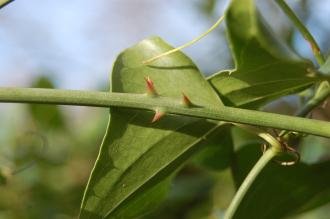
Smilax aspera (02/02/2014, Kew Gardens, London)
Position: Full sun to dappled shade
Flowering period: Late summer to early autumn
Soil: Moist, well drained
Eventual Height: 3m
Eventual Spread: 3m
Hardiness: 9a, 9b, 10a, 10b, 11, 12, 13
Family: Smilacaceae
Smilax aspera is an evergreen flowering vine with a scrambling/ climbing habit. Its glossy dark green leathery leaves cordate with entire margins, up to 10cm long and 6cm broad. Tendrils appear from the base of its leaves enabling this plant to self cling. Its stems are flexible and have sharp thorns and each stem may achieve a length of up to 15m. Its dioecious yellow/ green fragrant flowers are small and appear as axillary racemes. Its fruit on the female plants are globose berries which are up to 1cm across, the are initially red and turn black with age.

Smilax aspera Leaf (02/02/2014, Kew Gardens, London)
Smilax aspera, commonly known as Common Smilax, Rough Bindweed, Prickly Ivy or Salsaparilla, is native to the Mediterranean region, parts of Africa and tropical Asia. In its native habitat it grows in woodland and scrub. This plant is considered a weed in some locations of the world due to its thorny, smothering nature.
The etymological root of the binomial name Smilax is derived from the Greek meaning ‘poison’, as Dioscorides described it as an antidote to poison. Aspera is derived from the Latin meaning ‘sharp’ or ‘pointed’.
The landscape architect may find Smilax aspera useful as an evergreen barrier plant with fragrant flowers.

Smilax aspera Thorns (02/02/2014, Kew Gardens, London)
Ecologically, Smilax aspera flowers are attractive to pollinating insects. Its berries are attractive to many species of birds.
Smilax aspera prefers moist, fertile, well-drained soils. It tolerates most pH of soil.
Smilax aspera requires little maintenance.



COMMENTS ( 1 )